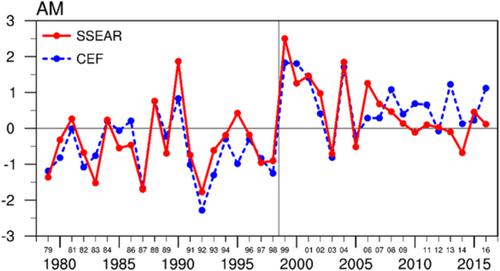当前位置:
X-MOL 学术
›
Int. J. Climatol.
›
论文详情
Our official English website, www.x-mol.net, welcomes your feedback! (Note: you will need to create a separate account there.)
Interdecadal variability of South–Southeast Asian rainfall and cross‐equatorial flows during April–May
International Journal of Climatology ( IF 3.9 ) Pub Date : 2020-07-08 , DOI: 10.1002/joc.6739 Jien‐Yi Tu, Jau‐Ming Chen, Min‐Hui Lo, Chia‐Wei Lan, Shui‐De Shiu, Tzu‐Ling Lai
International Journal of Climatology ( IF 3.9 ) Pub Date : 2020-07-08 , DOI: 10.1002/joc.6739 Jien‐Yi Tu, Jau‐Ming Chen, Min‐Hui Lo, Chia‐Wei Lan, Shui‐De Shiu, Tzu‐Ling Lai

|
From April to May, South–Southeast Asian rainfall (SSEAR) and cross‐equatorial flows (CEFs) off the East African coast have exhibited interdecadal variability over the past four decades. Both SSEAR and CEF strengthened based on comparative analysis for the periods 1979–1998 and 1999–2016. Associated modulating processes feature warm sea surface temperature (SST) anomalies in the tropical western North Pacific (WNP) and cold SST anomalies in the tropical eastern Pacific. These features lead to a low‐level clockwise circulation anomaly across the North and South Indian Ocean. This intensifies CEFs via anomalous southerly flows along the circulation's western section and transports moisture via anomalous westerly flows on its northern side that enhances SSEAR. After 1998, SSEAR and CEFs vary coherently from 1999 to 2005, but incoherently from 2006 to 2016. For coherent cases (1999–2005), warm SST anomalies in the tropical WNP invoke a clockwise circulation anomaly over the tropical Indian Ocean. Meanwhile, cold anomalies in the tropical Indian Ocean and strong warm anomalies over Asian landmasses cause a meridional temperature difference (MTD) forming a strong cyclonic anomaly in the north that constrains the clockwise circulation anomaly south of 15°N. The circulation's western section enhances CEFs, while anomalous westerly flows on its northern side enhance moisture supply over southern parts of the Asian landmasses thereby increasing SSEAR. For incoherent cases (2006–2016), SST anomalies are warm in both the tropical WNP and Indian Ocean, while anomalous warming over Asian landmasses is more moderate. A weakened MTD yields an isolated weakened cyclonic anomaly in the north allowing for the development of a northward‐displacing clockwise circulation anomaly with anomalous westerly flows north of 20°N. Rainfall increases a little in northern parts of South–Southeast Asia but decreases noticeably in southern parts. Intensified CEFs thus occur concurrently with decreased SSEAR.
中文翻译:

四月至五月期间东南亚降雨和跨赤道流量的年代际变化
从四月到五月,在过去的40年中,东非沿海地区的东南亚降雨(SSEAR)和跨赤道流量(CEF)表现出年代际变化。根据比较分析,SSEAR和CEF在1979-1998年和1999-2016年期间均得到了加强。相关的调制过程的特征是热带北太平洋(WNP)的海温异常(SST)和热带东太平洋的冷SST异常。这些特征导致整个北印度洋和南印度洋的低水平顺时针环流异常。这通过环流西段的异常南风增强了CEF,并通过其北侧的异常西风流输送了水分,从而增强了SSEAR。在1998年之后,SSEAR和CEF在1999年至2005年之间变化一致,但是从2006年到2016年则是不连贯的。对于连贯的情况(1999-2005年),热带WNP中的暖SST异常会调用热带印度洋上的顺时针环流异常。同时,热带印度洋的冷异常和亚洲陆块的强烈暖异常导致子午温差(MTD)在北部形成强烈的气旋异常,从而限制了15°N以南的顺时针环流异常。环流的西部增加了CEF,而北侧的异常西风流动增强了亚洲大陆南部的水分供应,从而增加了SSEAR。对于不连贯的情况(2006-2016年),热带WNP和印度洋的SST异常温暖,而亚洲陆地的异常变暖更为缓和。MTD减弱会在北部产生一个孤立的减弱的气旋异常,从而导致向北位移的顺时针环流异常发展,西风向北偏北20°。东南亚北部的降雨量略有增加,但南部的降雨量明显减少。因此,CEF增强与SSEAR降低同时发生。
更新日期:2020-07-08
中文翻译:

四月至五月期间东南亚降雨和跨赤道流量的年代际变化
从四月到五月,在过去的40年中,东非沿海地区的东南亚降雨(SSEAR)和跨赤道流量(CEF)表现出年代际变化。根据比较分析,SSEAR和CEF在1979-1998年和1999-2016年期间均得到了加强。相关的调制过程的特征是热带北太平洋(WNP)的海温异常(SST)和热带东太平洋的冷SST异常。这些特征导致整个北印度洋和南印度洋的低水平顺时针环流异常。这通过环流西段的异常南风增强了CEF,并通过其北侧的异常西风流输送了水分,从而增强了SSEAR。在1998年之后,SSEAR和CEF在1999年至2005年之间变化一致,但是从2006年到2016年则是不连贯的。对于连贯的情况(1999-2005年),热带WNP中的暖SST异常会调用热带印度洋上的顺时针环流异常。同时,热带印度洋的冷异常和亚洲陆块的强烈暖异常导致子午温差(MTD)在北部形成强烈的气旋异常,从而限制了15°N以南的顺时针环流异常。环流的西部增加了CEF,而北侧的异常西风流动增强了亚洲大陆南部的水分供应,从而增加了SSEAR。对于不连贯的情况(2006-2016年),热带WNP和印度洋的SST异常温暖,而亚洲陆地的异常变暖更为缓和。MTD减弱会在北部产生一个孤立的减弱的气旋异常,从而导致向北位移的顺时针环流异常发展,西风向北偏北20°。东南亚北部的降雨量略有增加,但南部的降雨量明显减少。因此,CEF增强与SSEAR降低同时发生。


























 京公网安备 11010802027423号
京公网安备 11010802027423号